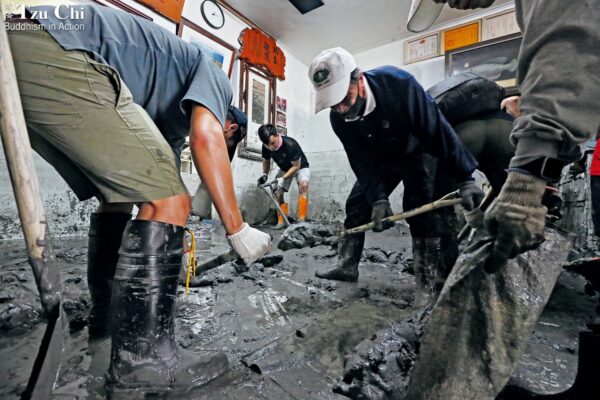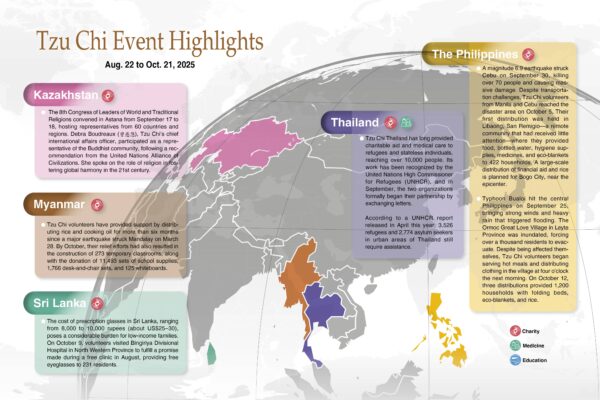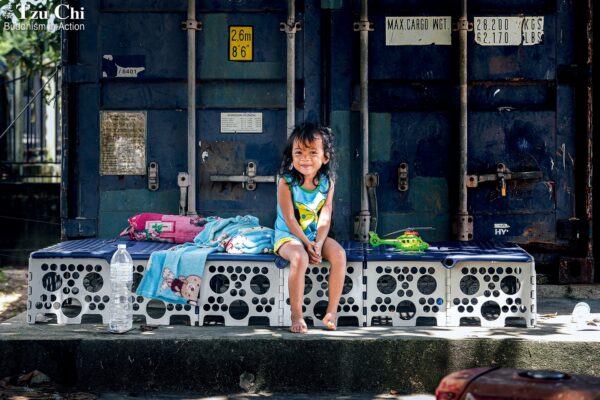By Wo Soek Meng, Soo Choon Lan, Sia Ah Tong, and Kong Siew Yen
Translated by Wu Hsiao-ting
Severe floods upended lives in East Malaysia. Tzu Chi volunteers stepped in, offering both practical support and emotional comfort.
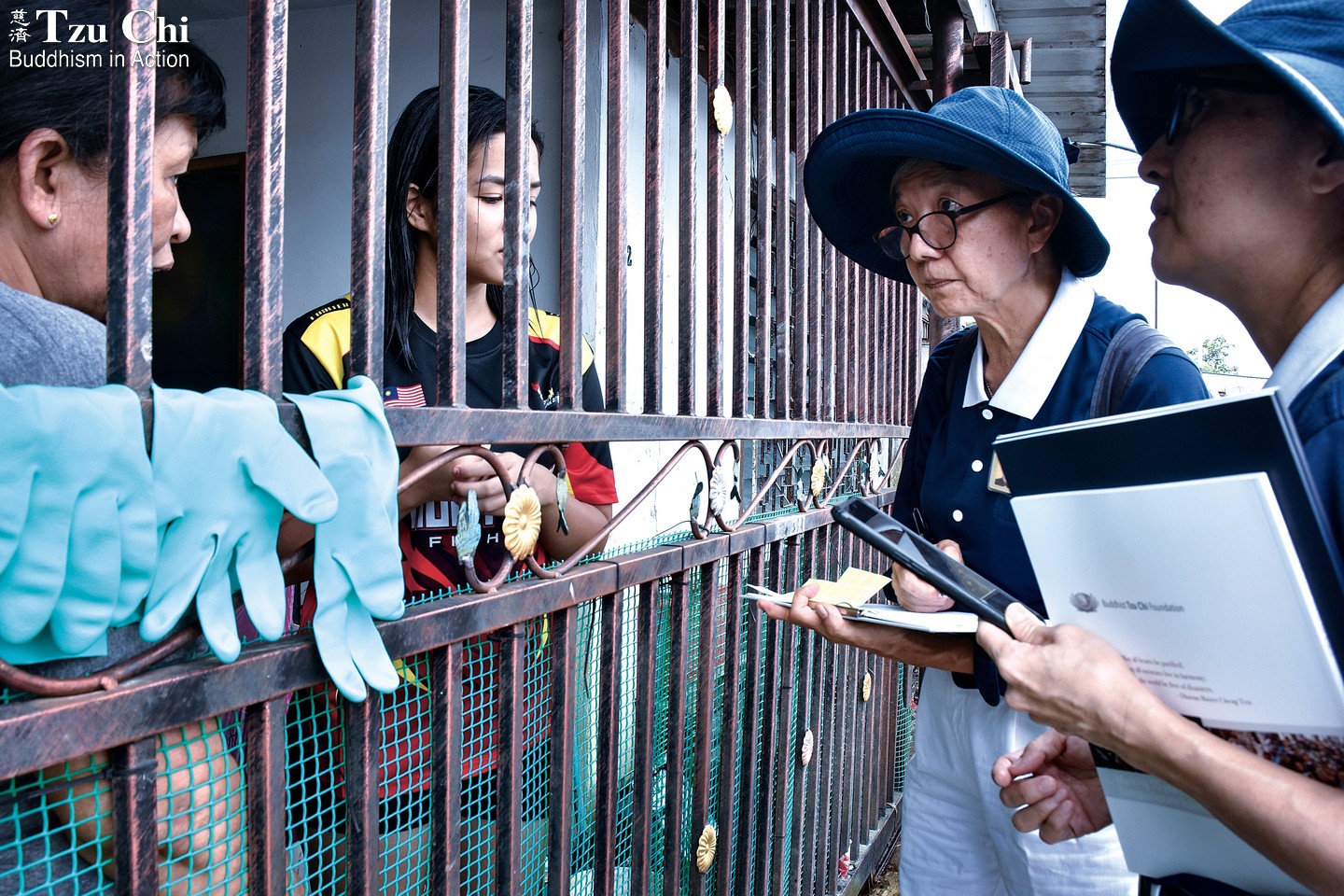
Volunteers visit a household in flood-affected Bintulu as part of their mission to offer care and gather information to compile a list of aid recipients. Fu Oi Jong
Just after four in the morning, 50-year-old Noor Aini Yussof was woken when her child, who had gotten up to use the restroom, called out to her—floodwaters were pouring into their home. The family of five scrambled to raise their furniture and appliances, but the relentless waters kept rising, forcing them to flee.
With no rescue boats in sight, the family waded through the floodwaters to an evacuation center, enduring a harrowing journey that seemed endless. “We trudged through water that went from waist-deep to neck-deep,” Noor Aini recalled. “We even saw small snakes and centipedes floating in the water. My child, terrified, asked if crocodiles would appear too. I could only tell him, ‘We can’t worry about that. We need to escape!’”
Noor Aini and her family left their home at the end of January and didn’t return until February 8. When they returned, they found that everything—furniture, appliances, and even a motor scooter—had been ruined by the sudden flood. Her tears wouldn’t stop. The children were about to start school, but the new clothes she had bought for them were gone as well. The only two mattresses they had were from the evacuation center. The floor was cold, so Noor Aini and her husband let their three children use the mattresses, while they themselves slept on a canvas sheet laid directly on the floor.
From January 28 to 30, heavy rains lashed East Malaysia, triggering severe floods in Keningau, Sabah, and Miri and Bintulu, Sarawak. Noor Aini lives in Sibuti, a town located in Miri that was nearly entirely submerged.
This was the worst flood Miri had experienced since 1981. Residents were caught completely unprepared. Communication, electricity, and transportation were all cut off. With a temporary shortage of rescue boats, people banded together to help the elderly, children, and disabled reach evacuation centers safely. Some in more remote areas were trapped by floodwaters higher than their heads and took two or three days to rescue. Afterward, whenever the sky darkened and the rain began, an air of anxiety settled over the disaster zone.
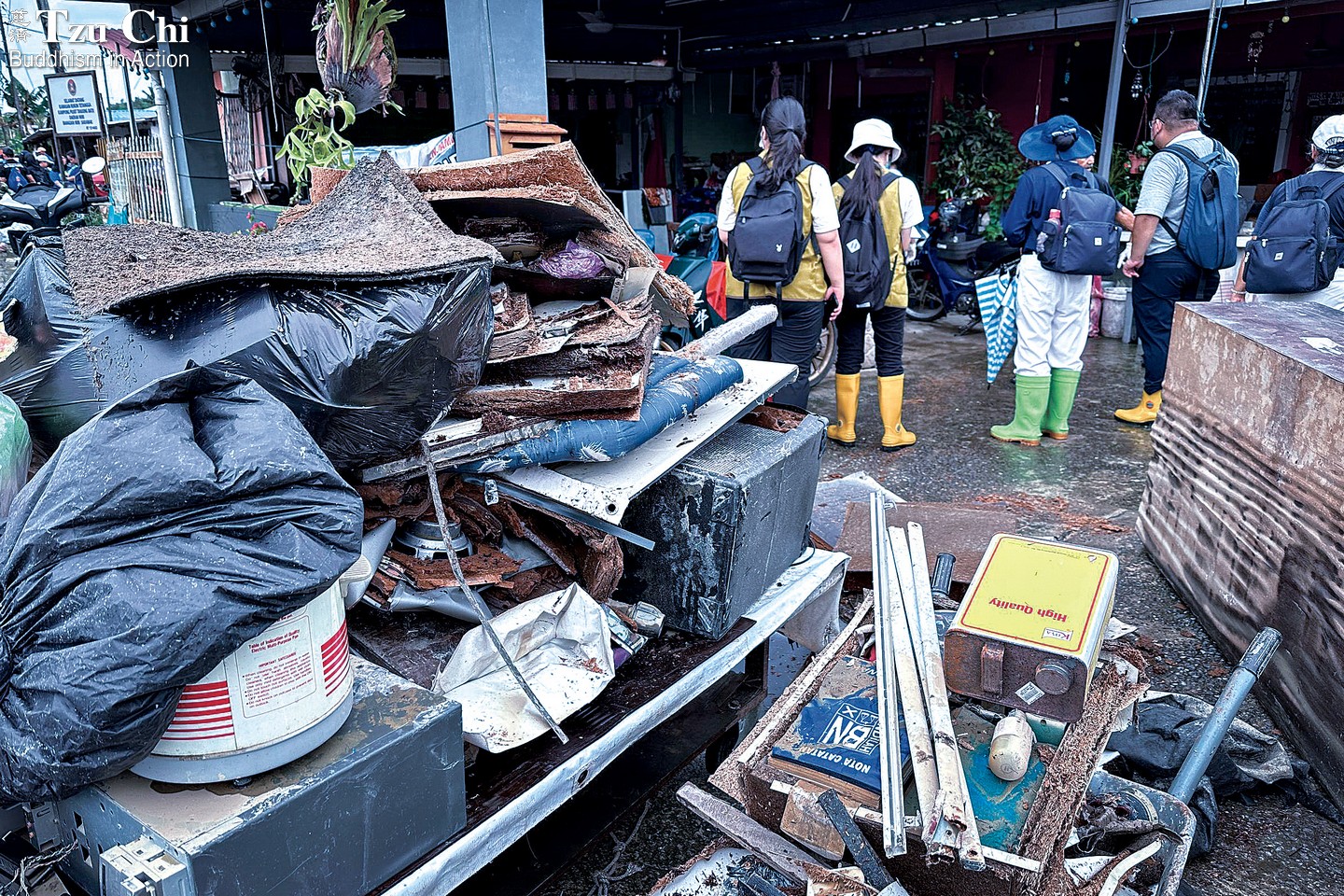
When volunteers visited Miri to identify flood-affected households in need of assistance, they found mud and standing water everywhere, with debris piled up along the roadside. Kong Lee Jing
A disaster during Lunar New Year
The floods struck during the Chinese Lunar New Year, a time traditionally reserved for family gatherings and celebrations. However, for Hwong Wun Kwong (方文光) and his fellow volunteers in Miri, the holiday quickly took a back seat to the urgent need for assistance. On the first day of the Lunar New Year, January 29, Hwong, along with several other volunteers, rushed to assist evacuees. It was still raining, and temperatures had dropped. Concerned that the cold might affect children and the elderly, the volunteers first delivered blankets that evening, followed by basic necessities. With large wholesalers closed for the holiday, they scoured smaller stores to gather enough supplies, which they distributed the following day. “We no longer care about missing New Year family dinners or visits to relatives,” said Hwong. “What matters now is how we can help those affected.”
SJK(C) Chung Hua Sibuti, a school, was severely damaged by the flood. Volunteers helped clean the campus and later provided desks, chairs, and cabinets to support the reopening of classes.
To better understand conditions in the flood-affected areas and ensure that aid reached the families most in need, Tzu Chi volunteers in Miri decided to conduct home visits and register households requiring assistance. They initially planned to request support from volunteers in Kuala Lumpur, Selangor, and other regions. However, upon learning that the situation in Bintulu was even more severe and that there was an even greater shortage of manpower there, Hwong said, “We’ll rely on ourselves.” In the end, they invited only 15 volunteers from Kuala Lumpur and Selangor to join them. “Our team believes that if we put our hearts into the work, we’ll find a way, and real-life bodhisattvas will appear to help. With firm resolve comes strength!” Hwong exclaimed.
On February 8 and 9, volunteers carried out home visits in two hard-hit areas: Sibuti and Pujut Tanjung Batu. Over a hundred people, including non-Tzu Chi volunteers, had signed up to help. The adequate manpower allowed the task to be completed.
Mohammad Rasool, the village chief of Kampung Jengalas in Sibuti, assisted volunteers with the registration. “Our village has flooded before,” he said, “but the water never got very high. Maybe that’s why people forgot what a threat floods could be.”
Khoo Kim Chiew (邱勁順), a volunteer with Tzu Chi Kuala Lumpur and Selangor, was among the team conducting the home visits. He had promised to meet old classmates during the New Year. However, when he heard about the disaster in Miri, he decided to change his plans and fly across the South China Sea to lend a hand. “Registration isn’t just about collecting data—it’s also about offering genuine care and soothing troubled hearts,” he said. “After identifying those needing our help, we provide financial aid to ease their pressures and burdens, helping them restore their homes and lives with greater peace of mind.”
The flood spared no one, submerging everything, regardless of wealth. Khoo noted that while some victims were financially secure, their emotional distress still needed attention. “We offer comfort and consolation the best we can,” he said, “hoping that, one day, they might also reach out to others facing difficult times.”
In February, volunteers conducted five aid distributions in Miri, Bintulu, and Keningau to support flood survivors and help them on their path to recovery. Koo Han Wu
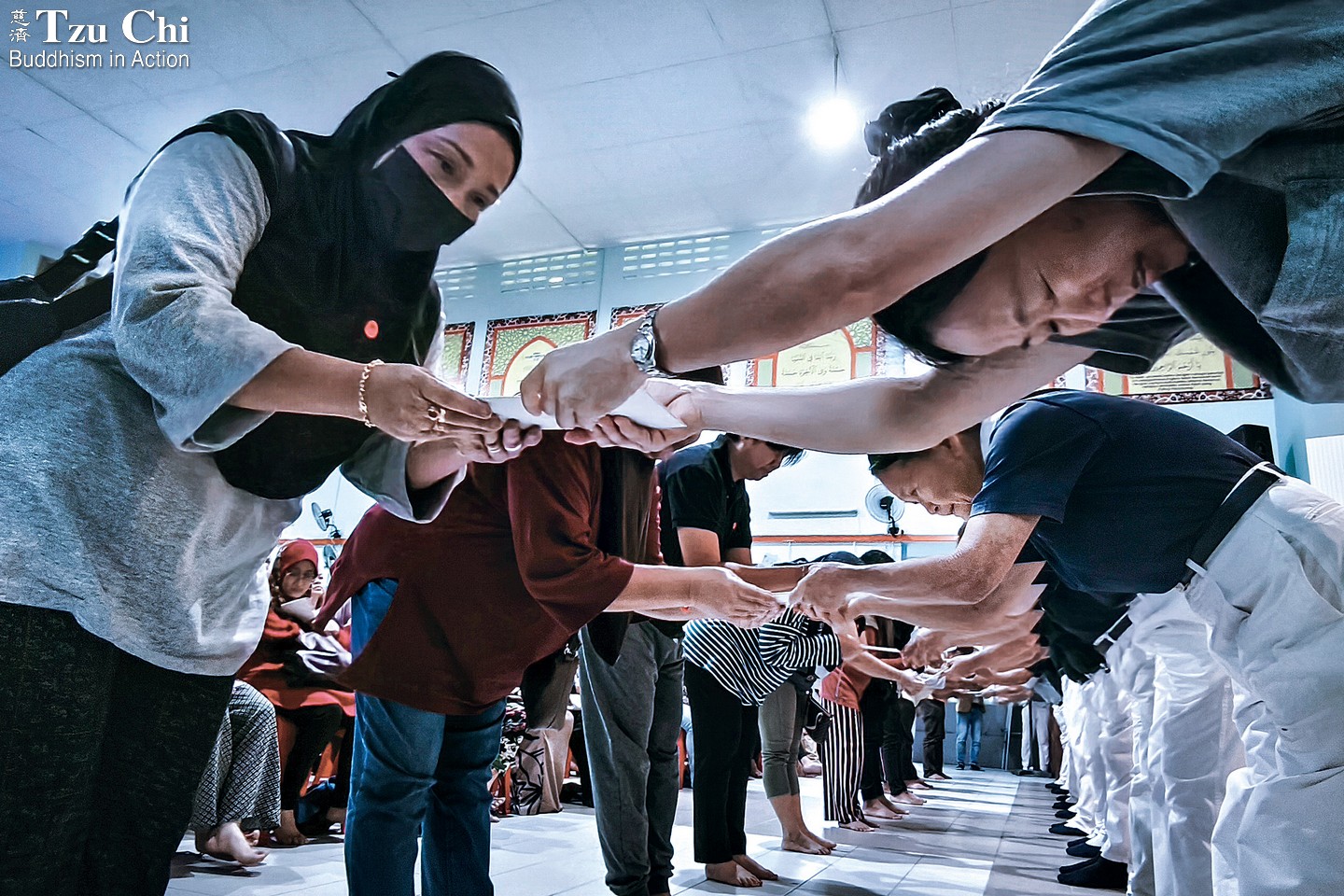
Work in Bintulu
Meanwhile, over 170 volunteers from Kuala Lumpur and Selangor traveled to Sarawak to join 23 local volunteers in visiting flood-stricken areas in Bintulu. Despite it being the Lunar New Year period—when flights from West Malaysia to East Malaysia were limited and fares were high—not a single volunteer backed out. The affected areas were in poor condition, with a persistent light rain falling. Donning raincoats, the volunteers visited the communities in groups. From February 6 to 9, they made intensive visits to over 4,600 households. They witnessed first-hand the challenges many residents were facing, which made their efforts feel all the more meaningful.
The Sebiew River, which runs through the city center of Bintulu, had overflowed during the disaster, with water levels in some places rising more than a story high. To help cover the wide expanse of affected areas, a local 4×4 vehicle club dispatched 44 vehicles to assist in transporting the volunteers.
Along the riverbank lies a district comprised of houses on stilts. More than ten of those homes had been completely destroyed. Fifty-four-year-old Juluming Ak Achu recalled waking at 5 a.m. to find floodwaters already entering his room. “I notified my neighbors and friends, and we rushed to higher ground,” he said. The torrential rain lasted for 30 hours. They stayed awake all night, anxiously watching the rising waters. In the end, the flood swallowed his home.
The stilt house of another resident, Lium Anak Unpeng, had stood by the river for over 40 years. This was the first time it had ever flooded—though it was still standing. He explained that most people in the area are low-income families, which is why they built simple wooden houses near the river. Now that their homes were gone, he wondered, what were they supposed to do?
Lee Chee Choon (李志忠), a volunteer with Tzu Chi Kuala Lumpur and Selangor, led eight groups of volunteers in compiling recipient rosters in Bintulu. While walking down an alley in Kampung Kemunting, he met a worried-looking man named Zainal. After introducing himself and explaining their mission, Lee asked how they could help. Zainal thought for a moment, then said, “Maybe some clothes?” His sadness seemed to take hold of him, and he burst into tears.
Zainal shared that Tzu Chi was the first organization to offer help in his area. His family of 23 had fled during the initial wave of the disaster, carrying his elderly father, who had suffered a stroke and had difficulty moving, to safety on foot. Though they all escaped unharmed, the flood had devastated their home. They had spent several days cleaning but were not done yet. Water-damaged debris piled up outside their door, and the living room had become a place to dry kitchenware.
They were sleeping on flattened cardboard boxes and had no means to cook. A craftsman by trade, Zainal planned to slowly repair his home. He tried to take in stride what had happened. Though his family had suffered, he realized the damage from the flood was widespread and that many others were even worse off.
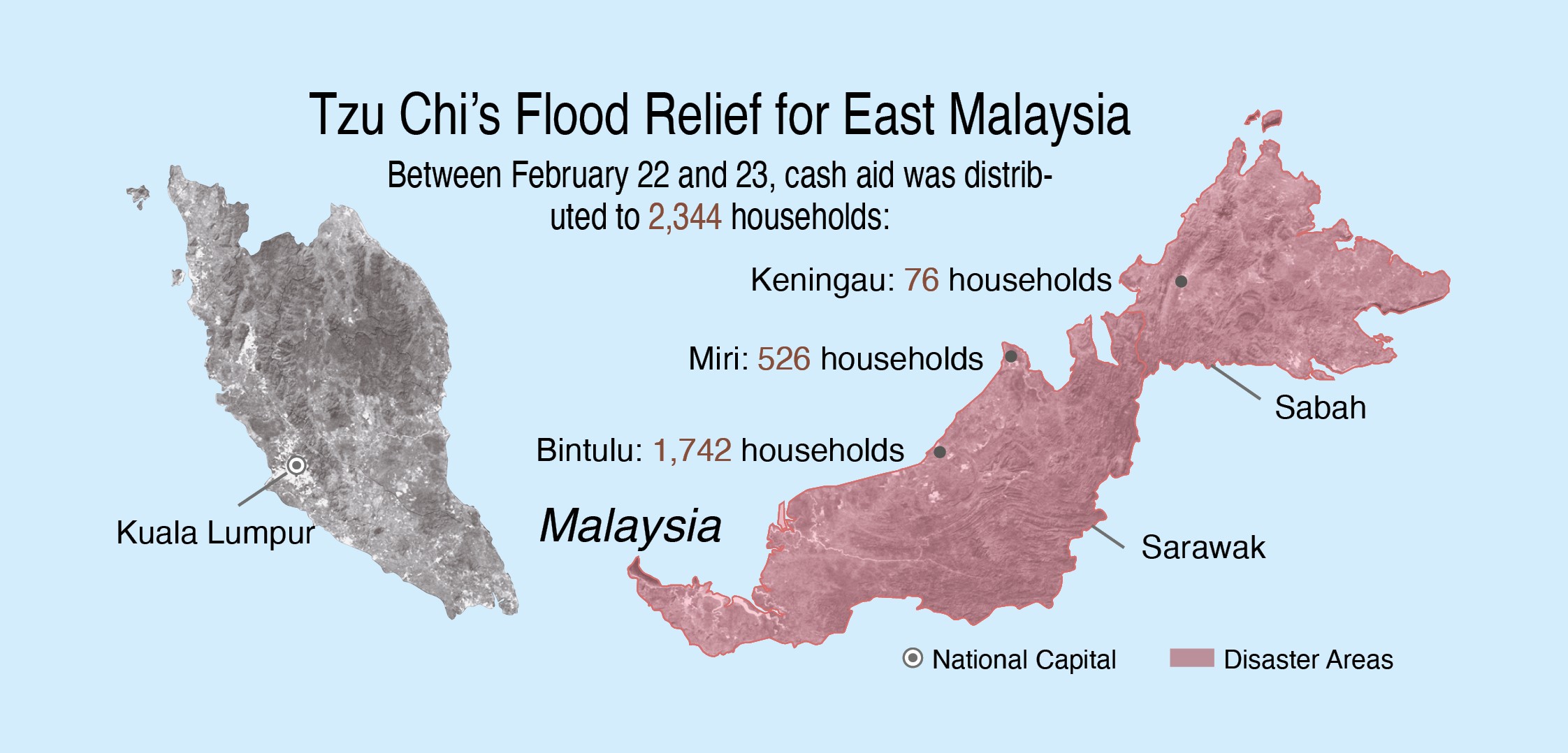
Distributions before Ramadan
Torrential rains also struck Sabah, causing severe flooding in Keningau on February 5. The downpour damaged water pipes, cutting off the local water supply. As the waters receded, thick layers of mud blanketed the city center and surrounding areas. Residents were left without access to clean water or electricity, so Tzu Chi volunteers responded swiftly. They began by delivering hot meals, then overcame numerous logistical challenges to deploy a water truck to supply residents with water. Households affected by the flooding in Keningau also received aid through Tzu Chi’s relief distributions.
On February 22 and 23, a total of 239 volunteers mobilized for five distributions in Miri, Bintulu, and Keningau, benefiting 2,344 households. Each family received a letter of consolation from Dharma Master Cheng Yen, along with a cash card. The value of each card—ranging from 1,500 to 2,500 ringgit (approximately US$335 to 558)—was determined based on household size and could be redeemed for cash at local banks within a specified period.
At one of the distributions, as the Malay version of the Tzu Chi song “One Family” played and volunteers led everyone in signing the lyrics, Yahya Bin Sulaiman, seated in the front row, repeatedly wiped away tears. Afterwards, volunteers approached him, gently offering comfort and asking if he was all right. His voice trembling, he said, “My home is empty now. There’s nothing left.”
Yahya lives in Pujut Tanjung Batu. He recounted how, when the flood began, he first helped his mobility-impaired wife to a neighbor’s upper floor, then took his two younger children to stay with a relative. He returned to take his wife and two older children to safety. By then, the water had risen to waist level, but there was no time to be afraid—his only thought was ensuring his family’s safety.
Later, Yahya received a message from Tzu Chi inviting his family to the distribution. “Tzu Chi’s help is our first monetary aid since the flood,” he said. “With Ramadan and Eid al-Fitr approaching, this has really eased our burden. This support gave me hope—I’m truly grateful to Tzu Chi for treating us like family.”
Many recipients expressed similar gratitude. One said, “The volunteers provided top-notch service throughout the distribution, from the moment we arrived.” Another shared, “When I received Tzu Chi’s message inviting me to receive aid, I sincerely thanked Allah.” A third remarked, “Tzu Chi doesn’t distinguish between races or religions—they truly embody humanitarian values.”
Natural disasters often strike fiercely, uninvited and without warning. But when the clouds part, the sun shines through. In the same way, the light of love and care shines through following a disaster, softly illuminating even the darkest corners of the heart.

